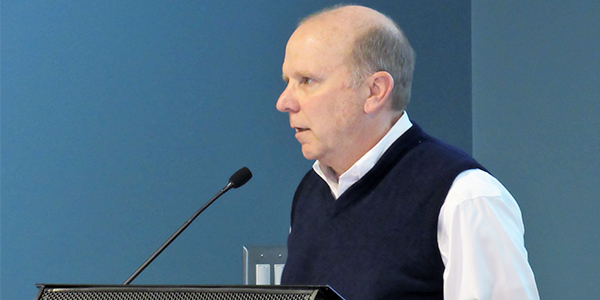CARMEL, Ind. — MISO’s Independent Market Monitor intends to reduce its monitoring of physical withholding by small behind-the-meter generators in the footprint.
Most of MISO’s BTMGs are about 2 MW, and the Monitor is proposing only monitoring for physical withholding by units of at least 10 MW. It would still not recommend enforcement action for any possible economic withholding from BTMGs.
“Excluding these resources will improve efficiency, allowing for more focus on resources that may have market power,” the Monitor explained.

IMM staffer Michael Chiasson told the Resource Adequacy Subcommittee on Wednesday that he would only scrutinize aggregated nodes of BTMG for physical withholding if one of those groups contained a generator larger than 10 MW. Groups that contain multiple smaller generators that exceed 10 MW combined would still be left alone.
According to the Monitor’s count, MISO contains 826 BTMGs, with 547 of those serving as load-modifying resources. BTMG comprises just 5,089 MW of MISO’s Generation Verification Test Capacity and 4,582 MW of unforced capacity.
Minnesota Public Utilities Commission staff member Hwikwon Ham asked if the Monitor foresees large groups of small BTMGs exercising market power.
“We still think that they’re unlikely to have market power,” Chiasson said. “If we do see something that’s alarming, that doesn’t prevent us from taking action and filing a recommendation with FERC. Our hands really aren’t tied here.”
“Is this in the spirit of [ERCOT’s philosophy that] ‘small fish swim free?’” MISO’s Michael Robinson asked.
Chiasson said he wasn’t familiar with ERCOT’s controversial protections for small generators that control less than 5% of the Texas wholesale energy market. Such generators are dubbed too small to hold market power and are exempt from penalties for market power abuse.
“The small fish can be pivotal in certain circumstances,” Customized Energy Solutions’ David Sapper said.
MISO staff said that if supplies ever became so scarce that small BTMGs become pivotal suppliers and rake in higher prices, they would deserve the high compensation for providing a critical service.
Staff said the new BTMG physical withholding rule would likely be included in a monitoring rule update filed at FERC before fall.
Additionally, the Monitor plans to add default technology-specific avoidable costs for solar generation and battery storage at $64.11/MW-day and $109.59/MW-day, respectively.
Most of MISO’s capacity market participants elect to use the Monitor’s default avoidable costs, saving time and effort rather than calculating and documenting individual refence levels for generation. The Monitor relies on the same values PJM currently uses, although PJM does not maintain values for solar and storage.
MISO Reviews OMS Survey
MISO staff took time to reassess with stakeholders the results of last month’s annual Organization of MISO States resource adequacy survey.
The survey forecasts a generation surplus of about 3 to 6 GW in 2020, about 1 to 4 GW in 2021 and about 1 to 3.4 GW in 2022. The range of possibilities in 2023 and 2024 varies the most, with the forecast indicating anything from a 1.3-GW shortfall to a 7-GW surplus in 2023, and a 2.3-GW shortfall to another 7-GW surplus in 2024. This is the sixth iteration of the survey. Last year’s forecasted a possible 0.1-GW shortfall in 2020. (See Supply Future Brighter, OMS-MISO Survey Shows.)
“Quite a few resources have firmed up their availability over the last year,” MISO’s Stuart Hansen said. “We’re resource-sufficient for the next three years. It’s 2023 and 2024 when we may have a problem area.”
But Hansen said that even in those years MISO by no means has a guaranteed adequacy risk. He said changes in load and new resource additions from the approximately 100-GW interconnection queue could come online and mitigate possible shortfalls.
“Every single year, we’re going to see this change,” he said, adding that 2020 “looked bad” from last year’s perspective but has since become “3 GW long.”
MISO is circulating survey results with state public service commissions in its footprint.
“I’m not too concerned,” Hansen said of forecasted potential deficits. “This survey is a tool to open dialogues with state commissions [and] utilities.”
The Coalition of Midwest Power Producers’ Mark Volpe asked why MISO is initiating outreach on the survey with state commissions when it is market participants that respond.
Hansen said the RTO is simply ensuring states are aware of the survey’s resource adequacy results. He said MISO does not cross-check survey results against states’ integrated resource plans.
Volpe also asked if MISO may recalibrate survey results based on new public announcements regarding retirements and new plant construction.
“We may look at that, but we do have a cutoff period. At some point, those would become part of the 2020 survey. If you’re asking if we would open it up now, probably not,” Hansen said.
But Hansen reassured stakeholders that the survey results include the Illinois Pollution Control Board’s June 20 announcement of the retirement of 2 GW of coal-burning generation in the state. Southern Illinois’ Zone 4 is one of three local resource zones in MISO that could experience capacity shortfalls from 2020 to 2024.
— Amanda Durish Cook




